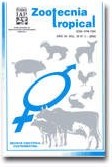
|
Zootecnia Tropical
Instituto Nacional de Investigaciones Agrícolas Venezuela
ISSN: 0798-7269
Vol. 29, No. 4, 2011, pp. 411-420
|
 Bioline Code: zt11036
Bioline Code: zt11036
Full paper language: English
Document type: Research Article
Document available free of charge
|
|
|
Zootecnia Tropical, Vol. 29, No. 4, 2011, pp. 411-420
| en |
Influence of some factors in the crude protein yield of mulberry ( Morus alba  l.) in Trujillo, Venezuela l.) in Trujillo, Venezuela
García, Danny Eugenio; Medina, María Gabriela; Perdomo, Daniel Antonio; Moratinos, Pedro; Cova, Luís & Clavero, Tyron
Abstract
An experiment was carried out in Trujillo state, Venezuela in order to study the effect of variety (Cubana,
Indonesia, Tigreada, Acorazonada, Tailandesa, Guatemalteca and Criolla), cut frequency (60, 90 and 120 days),
organic fertilization (0, 150 and 300 kgN/ha/year) on gross protein yield (PB) of leaves and edible stems of
Mulberry ( Morus alba

L.) in two seasonal periods (PLL and PPLL), using a randomized blocks design with
factorial arrangement 7 x 3 x 3 and fi ve replicates for treatment. Significant interactions among the evaluated factors were not observed (P>0.05). Statistical differences in the proteic yield among varieties (leaves: 324.71-
365.17; edible stems: 26.47-30.83 kgPB/ha/cut) were not observed. However, in the PPLL the Indonesia (144.14
kgPB/ha/cut) and Guatemalteca (164,00 kgPB/ha/cut) varieties stood out for their yield on leaves, while the
Cubana exhibited the lowest result on edible stems. In PLL, with 90 days between cut on leaves and the edible
stems superior yields were observed. Nevertheless, in the PPLL the highest result on leaves was obtained with
cut every 120 days, and every 90 days for edible stems. Independently of the part of the plant and the season, the
biggest proteic yields were obtained with fertilization (edible biomass: 101.71-362.71 kgPB/ha/cut). The proteic
yield of Mulberry presented a marked varietal influence in the PPLL, where the Indonesia and the Guatemalteca
stood out. The spaced cut frequencies (90 and 120 days); and the fertilization influenced positively in the increase
of the proteic yields of the specie.
Keywords
mulberry, fertilization, variety, cut frequency, protein yield.
|
| |
| es |
Efecto de algunos factores que influyen en el rendimiento de proteina bruta de la Morera ( Morus alba  L.) en el estado Trujillo, Venezuela L.) en el estado Trujillo, Venezuela
García, Danny Eugenio; Medina, María Gabriela; Perdomo, Daniel Antonio; Moratinos, Pedro; Cova, Luís & Clavero, Tyron
Resumen
Se realizó un experimento en el estado Trujillo, Venezuela, con el objetivo de estudiar el efecto de la variedad
(Cubana, Indonesia, Tigreada, Acorazonada, Tailandesa, Guatemalteca y Criolla), la frecuencia de corte (60, 90
y 120 días) y la fertilización orgánica (0, 150 y 300 kgN/ha/año) en el rendimiento de proteína bruta (PB) de las
hojas y los tallos tiernos de la morera (Morus alba L.) en dos épocas del año período lluvioso (PLL) y período
poco lluvioso (PPLL), mediante un diseño de bloques al azar con arreglo factorial 7 x 3 x 3 y cinco réplicas por
tratamiento. No se observaron interacciones significativas entre los factores evaluados (P>0,05), ni diferencias
estadísticas en el rendimiento proteico de las variedades (hojas: 324,71-365,17; tallos tiernos: 26,47-30,83 kgPB/
ha/corte). Sin embargo, en el PPLL las variedades Indonesia (144,14 kgPB/ha/corte) y Guatemalteca (164,00
kgPB/ha/corte) sobresalieron por su rendimiento en las hojas, mientras que la Cubana exhibió el resultado más
bajo en los tallos tiernos. En el PLL, con la frecuencia de corte de 90 días en las hojas y los tallos tiernos se
observaron rendimientos superiores. No obstante, en el PPLL el resultado más sobresaliente en las hojas se
obtuvo con cortes cada 120 días, y cada 90 días para los tallos tiernos. Independientemente de la parte de la planta
y la época del año los mayores rendimientos proteicos se obtuvieron cuando se fertilizó a razón de 150 y 300
KgN/ha/año (biomasa comestible: 101,71-362,71 kgPB/ha/corte). El rendimiento proteico de la morera presentó
una marcada infl uencia varietal en el PPLL, donde sobresalieron la Indonesia y la Guatemalteca. Las frecuencias
de corte más espaciadas (90 y 120 días); así como la fertilización influyeron positivamente en el aumento de los
rendimientos proteicos de la especie.
Palabras-clave
morera, fertilización, variedad, frecuencia de corte, rendimiento, proteína.
|
| |
© Copyright 2011 - Zootecnia Tropical
Alternative site location: http://www.sian.inia.gob.ve/repositorio/revistas_ci/ZootecniaTropical/ztindice.htm
|
|
